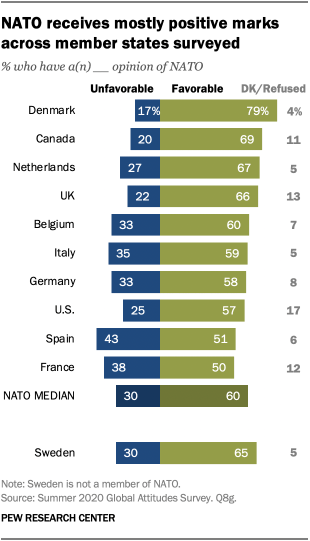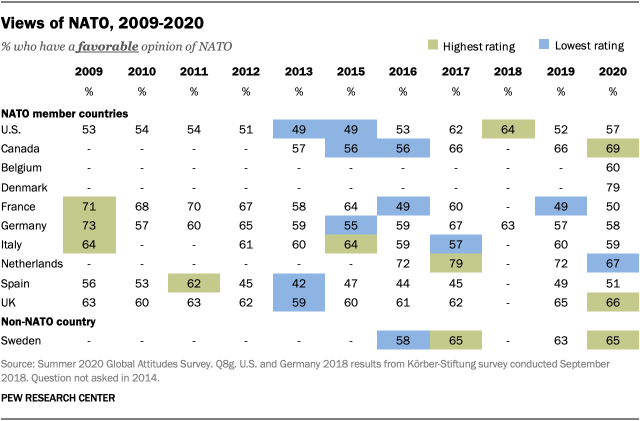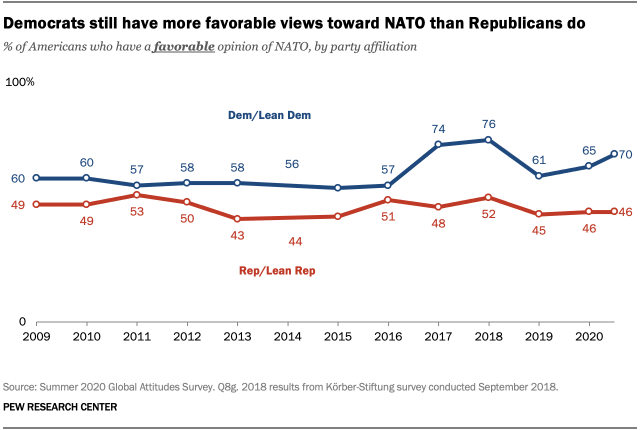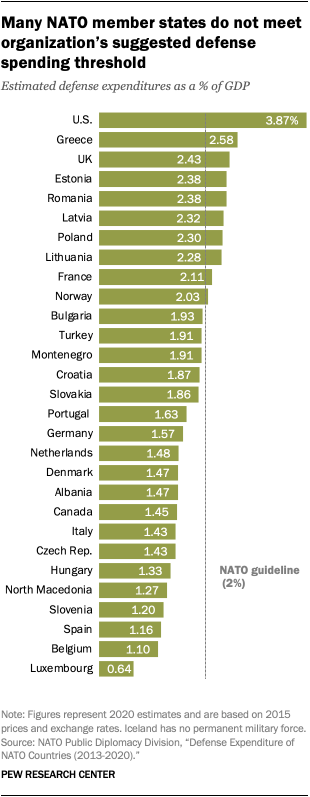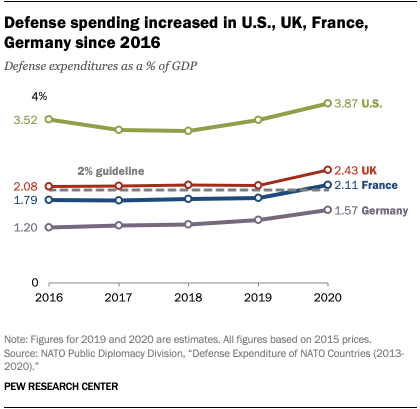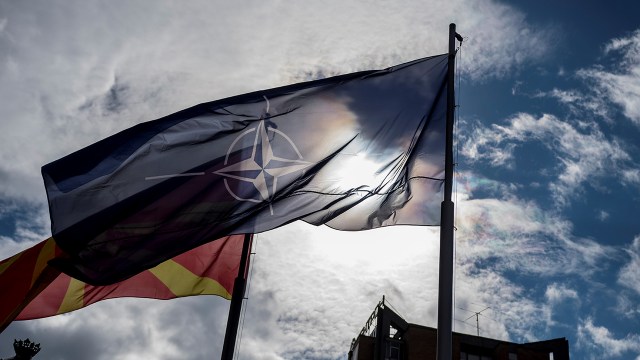
Note: For the Center’s most recent data on views of NATO, visit this post.
The North Atlantic Treaty Organization (NATO) is seen more favorably than not across 10 member states and Sweden. A median of 60% across these 10 countries have a favorable view of the political and military alliance, compared with a median of 30% who have an unfavorable opinion. This is in keeping with previous Pew Research Center surveys, which found that NATO was seen in a favorable light across most member countries.
Half or more people across all 10 NATO countries surveyed have a positive view of the organization, ranging from a high of 79% in Denmark to 50% in France. Among Americans, 57% have a favorable view of NATO, with only 25% expressing an unfavorable opinion (17% did not give a response). In five countries, about a third or more hold unfavorable opinions of NATO. The Spanish have the most unfavorable views among those surveyed: 43% have a negative opinion of the organization.
When surveyed in 2019, those in Central and Eastern European countries tended to have mixed responses toward NATO. In Poland and Lithuania, for example, over three-quarters had a favorable view of the alliance. However, in Slovakia, Hungary and Bulgaria, roughly half or fewer felt positively toward NATO. Unfavorable views of the organization were more widespread in Greece and Turkey, where 51% and 55% held negative views, respectively.
Pew Research Center has been tracking views of the North Atlantic Treaty Organization (NATO) since 2007. This analysis focuses on views of NATO among Sweden and 10 member nations in Europe and North America in a survey conducted across 10 countries from June 10 to Aug. 3, 2020, among 11,013 respondents. The analysis covers roughly 77% of the population living in NATO countries.
All surveys were conducted over the phone with adults in the U.S., Canada, Belgium, Denmark, France, Germany, Italy, the Netherlands, Spain, Sweden and the UK.
This study was conducted in countries where nationally representative telephone surveys are feasible. Due to the coronavirus outbreak, face-to-face interviewing is not currently possible in many parts of the world.
Here are the questions used for this report, along with responses, and its methodology.
NATO is seen favorably in Sweden as well. While not a member of NATO, 65% of Swedes see the organization in a positive light. A 2017 Center survey found that 47% of Swedes supported their country joining NATO, while 39% opposed membership (14% did not offer an opinion).
The Center has been tracking views of NATO in the countries surveyed since 2009. Over the past 11 years, favorable sentiment toward the alliance increased significantly in some countries (Canada, +12 percentage points from 2013, and Sweden, +7 points from 2016), while declining in others (Germany, -15 points from 2009, and France, -21 points over the same period).
Over the past year, favorable ratings of the organization have remained relatively stable across the 10 NATO countries included in the survey. And in two countries – Canada and the UK – favorable views of the organization are the highest recorded since the Center began asking this question in 2009.
In fact, in four countries with trends that date back to the Obama presidency, the highest ratings for NATO have been measured in the past four years, including in the United States. (The other three countries are Canada, the UK and Sweden.) And many other countries surveyed had seen a significant increase in favorable views of NATO between 2016 and 2017. In 2018, when President Donald Trump was explicitly criticizing the organization’s other member states for not contributing enough on defense spending, 64% of Americans expressed a positive view of NATO.
American views of NATO are shaped by political party affiliation, according to past Pew Research Center surveys. Historically, Democrats and Democratic-leaning independents are more likely to express a favorable opinion of the organization than Republicans and Republican-leaning independents. In the summer of 2020, seven-in-ten Democrats had a favorable view of NATO, compared with less than half (46%) of their Republican counterparts, a difference of 24 percentage points.
Among Democrats, NATO favorability has ticked up from 61% in 2019 to 70% this summer. Republican views of the alliance have held steady at roughly half since 2009, although in 2013, a record low of only 43% held a positive view of NATO.
In nine of the 10 NATO member states surveyed, those who favor compromise with other countries on international issues are more likely to have a favorable opinion of NATO than those who prefer a more independent approach. For example, in the Netherlands, 73% of those who say their country should take into account the interests of other countries even if it means making compromises with them express a positive opinion of NATO, compared with 59% who say their country should follow its own interests even when other countries strongly disagree. Double-digit differences on this question are present in the U.S., Denmark, Italy, Canada, Belgium and Germany.
In some cases, educational attainment also informs views of NATO: Across five NATO member states included in the survey, those with a postsecondary education or more schooling are more likely to have a positive opinion of NATO than those with a secondary education or less schooling. This difference is particularly large in Germany, where 70% of those with more education have a favorable view of NATO, compared with 54% of those with less education. In the U.S., those with more education are also more likely to provide a response.
NATO recommends member states commit 2% of their gross domestic product to defense spending, a guideline that has been in place since 2006. But just 10 of the 29 member states for which data is available spend 2% or more on defense. (Data is not included for Iceland, which has no permanent military force.)
The U.S. is the leading defense spender among member states, committing an estimated 3.87% of GDP to defense expenditures in 2020. Nine other countries – including several in Central and Eastern Europe – also meet NATO’s 2% threshold. Just one country – Luxembourg – spends less than 1% of GDP on defense.
While Trump has been openly critical of the level of allies’ defense spending, estimated defense expenditures as a share of GDP have risen since 2016, not only in the U.S. but among key NATO allies as well. For example, this year marks the first in which France is estimated to spend over 2% of GDP on defense. The UK has already reached this threshold, and German defense spending is on the rise.
Note: Here are the questions used for this report, along with responses, and its methodology.
